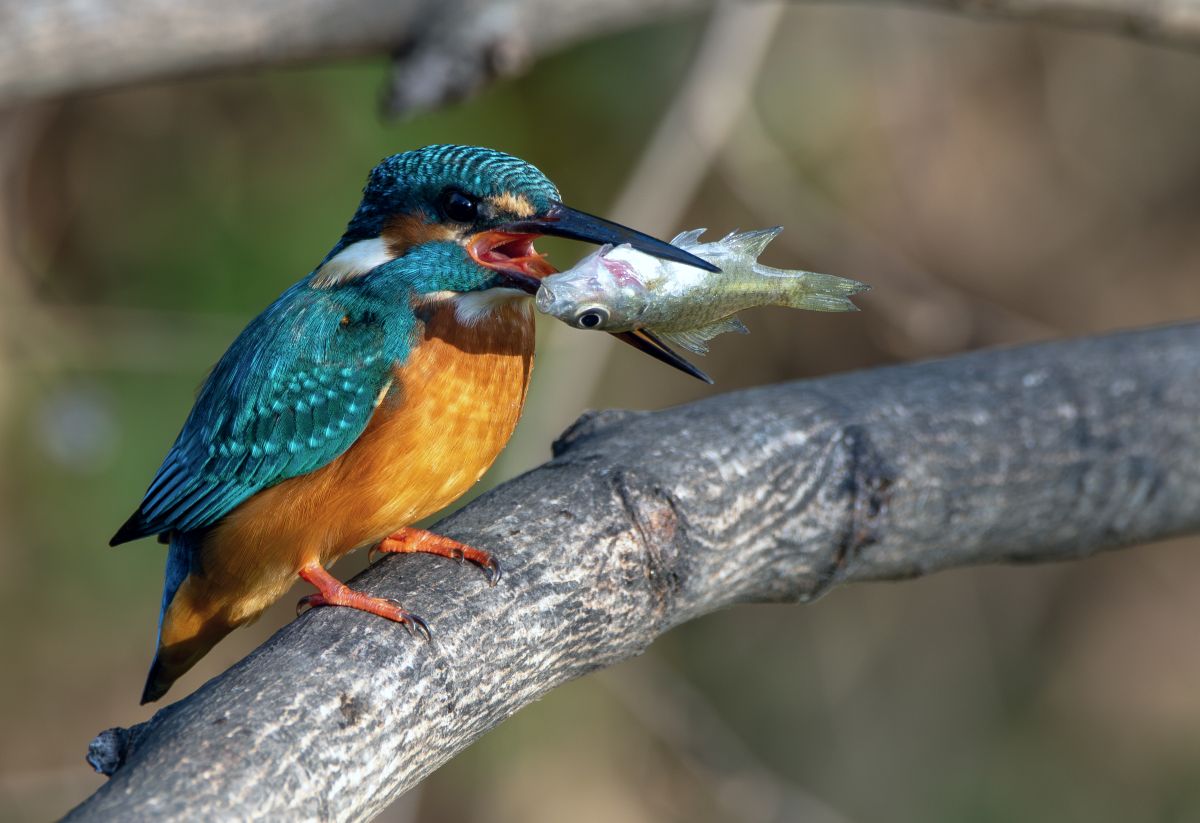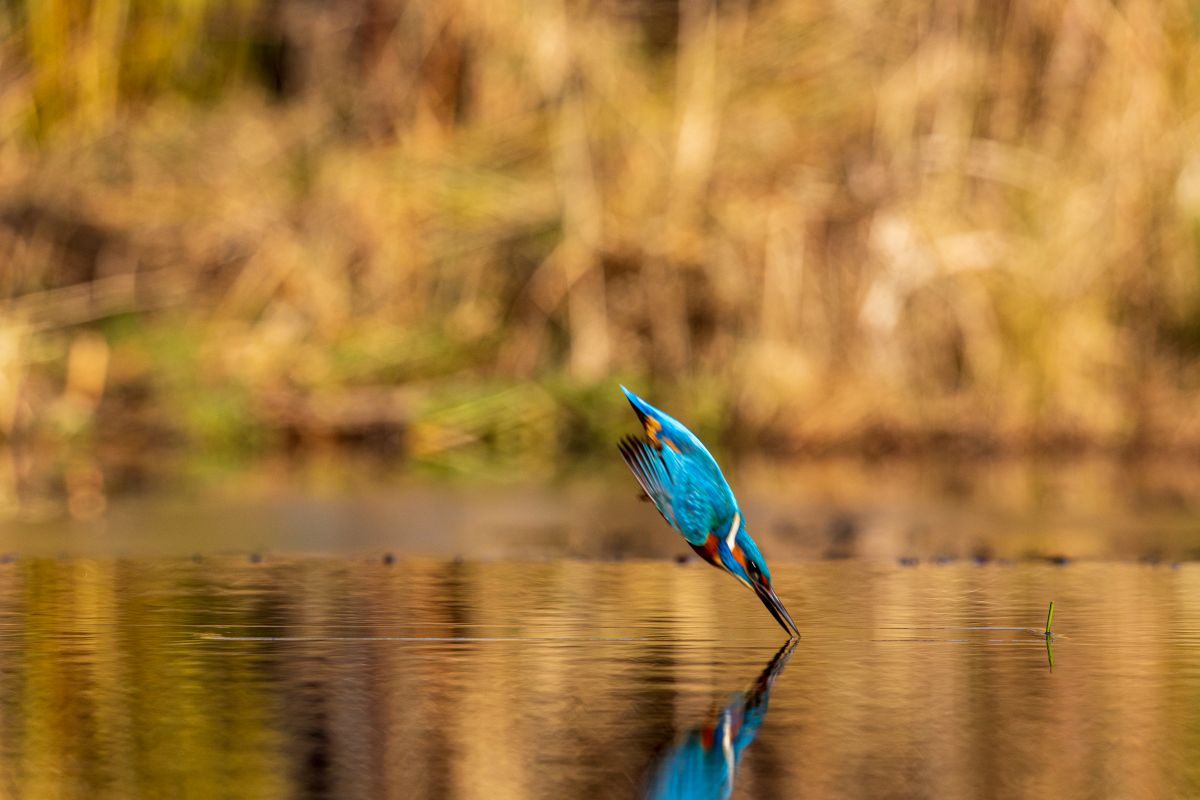
© Wikimedia Commons | Laitche CC BY-SA 4.0
Exploring the kingfisher, where every curve, colour, and calculation points to creation.
Musa Sattar, London, UK – Deputy Science Editor
You might never notice it until it moves. One second, it’s a blue flash on a quiet riverbank. The next, it’s a bullet plunging into water. A splash, and then it’s gone again, back on the branch, fish clamped in its beak. The kingfisher doesn’t just dive; it calculates, slices, stuns. In fact, it performs a manoeuvre so mathematically perfect that engineers, designers, and scientists have studied its every move to mimic its design.
Nature, in its infinite creativity, didn’t just make a bird. It made a living marvel.
Kingfishers are vibrant and typically classed as small to medium-sized, ranging in length from approximately 10 to 46 centimetres from the tip of their beak to the end of their tail. The smallest of them weigh about 10 to 15 grams. That’s lighter than a tennis ball. But don’t let the size fool you; this is no ordinary bird. Inside that compact frame is a design so fine-tuned, it puts our best machines to shame.
Have you ever stopped to wonder how a bird so light can fly through wind and sky without falling? The kingfisher hovers mid-air, wings outstretched, steady in the breeze, then folds into a blur, diving like a spear into water. What keeps it aloft? What holds it in balance? The Holy Qur’an reminds us: ‘Have they not seen the birds above them, spreading out their wings without moving them and then drawing them in to swoop down upon the prey? None withholds them but the Gracious God. Verily He sees all things.’[1]
In Barahin-e-Ahmadiyya Part IV, the Promised Messiah and Imam Mahdi, Hazrat Mirza Ghulam Ahmad (as) profoundly elaborates, ‘that even the birds, of which two or three may be purchased for a penny, fly happily and joyously in the vast expanse of this grace.’ [2] It’s a truth that’s as beautiful as it is deep. As Hazrat Mirza Ghulam Ahmad (as) explained, this effortless flight is not just a matter of physics. It’s a sign of Rahmaniyyat.
Another wonder of the kingfisher is its beak. It is long, straight, and pointed, acting like a biological spear. But it’s more than that. It’s a shock absorber. When the bird dives, it hits the water at around 40 to 50 kilometres per hour. The beak’s sleek, tapered design helps soften the impact by spreading out the pressure along its length. Yet despite entering the water at such high speeds, it doesn’t make a splash. Instead, it enters the water without a sound, so cleanly that barely any ripple forms. This is because its beak slices through the water, cutting down on drag, allowing silent entry, perfect for ambushing prey.
This breathtaking precision didn’t just impress bird watchers. It stunned engineers. In Japan, the creators of the Shinkansen bullet train had a problem – the train was very fast. But every time it exited a tunnel, it created a ‘sonic boom’. The air pressure difference was too great, disturbing people miles away. Designers needed a solution that nature had already solved. Engineer and birdwatcher Eiji Nakatsu saw the kingfisher’s design as the perfect solution to the Shinkansen’s aerodynamic challenge. The front of the train was reshaped to mimic the bird’s beak. The result? The train became quieter, more efficient, and even used less energy.
But the kingfisher hasn’t just inspired the designs of trains. Scientists continue to study the angles of its dive, the contour of its feathers, even the layering of its wings. The way the kingfisher moves through the air and water has inspired wind turbine designs, underwater probes, and aerodynamic structures.
Interestingly, kingfishers can hover in place with their heads perfectly steady, even when the wind shifts their bodies. Their sleek shape and balanced weight give them superb control in the air, helping them hunt with incredible precision. They also make smart use of their alula (a small, thumb-like feather on each wing) like a built-in airbrake to stay steady during slow landings or low-speed dives for prey.

© Shutterstock
Now, picture this. You’re flying above a river. The surface below is shiny. It moves. It reflects light. There are fish swimming, but they’re underwater. And water bends light. What you see on the surface isn’t always where the fish really is. Try throwing a pebble at a fish underwater. You’ll miss every time – but the kingfisher doesn’t. Why? Because its eyes have built-in corrections for this. As compared to other birds, they see with minimal visual distortion.
A kingfisher’s eyes change shape when it dives. Its lenses become rounder. That helps it adjust its focus mid-dive. And it doesn’t blink like we do. It uses a special eyelid called a nictitating membrane, a transparent shield that protects its eyes while still allowing it to see clearly underwater.
Even more fascinating is the fact that the kingfisher can see in both air and water simultaneously. It can estimate speed, distance, and movement with incredible accuracy. Its brain processes visual signals at lightning speed. This bird has the neurological equivalent of a supercomputer inside its head, built for one purpose: perfection in movement.
What happens when it spots a fish? It hovers for a moment, wings buzzing like a hummingbird, tail fanned, head locked. Then, it folds its wings and drops – just like a dart. Gravity, timing, muscle memory, and reflexes all work in harmony. It enters the water. A moment later, it rises, fish struggling in its bill.
Watching this flawless dive is breathtaking. Capturing it on camera? That’s a whole other feat. Wildlife photographer Alan McFadyen spent six years and over 720,000 attempts chasing that split-second moment – a kingfisher piercing the water in a perfect, splash-free dive. ‘The photo I was going for of the perfect dive, flawlessly straight, with no splash,’ he explained to Economic Times, ‘required not only me to be in the right place and get a very lucky shot but also for the bird itself to get it perfect.’ His obsession began with a childhood trip to a nest with his grandfather. ‘I just remember being completely blown away by how magnificent the birds are.’ That wonder never left him and it echoes in everyone who has ever witnessed that flash of blue and the silent poetry of a dive done right.
The kingfisher pulls off this amazing move by diving headfirst into water to catch the slippery fish. They perform this dangerous manoeuvre over and over again. But how do they do it without getting concussions? While the dive of that speed could easily cause injury, the kingfisher’s head and beak are shaped just right to handle the impact. It’s so clever that scientists are now looking at how this bird stays safe to help protect people from head injuries too. It’s another reminder that this tiny bird was made with incredible care and purpose.
Its body is built so it can dive this way: with very little fat, short legs and small feet. All of these features reduce drag, and allow it to plunge into the water and come out instantly.
Its feathers shimmer in the sun, but not with dye. The blue we see isn’t pigment; it’s structure. A kingfisher’s feathers scatter light in such a way that they reflect a brilliant blue. It’s an illusion created by structure. This phenomenon, known as structural colouration, occurs when microscopic layers in each feather bend and reflect light like a tiny, living prism.
In a fascinating 2011 study published in the Journal of Experimental Biology, Dr Bodo Wilts and his team examined this more closely and discovered that the vibrant blues and cyans come from spongy nanostructures inside each feather barb. These minute formations scatter light at just the right angles, and even the smallest differences in structure can create subtle shifts in shade.
Under a microscope, the fine kingfisher barbs, thinner than a strand of human hair, bounce light back at certain angles, revealing shades of the Caribbean: sapphire in one direction, emerald in the other. Interestingly, the kingfisher’s feathers are what scientists call semi-iridescent. Unlike the mirror-like iridescence of peacocks, these feather layers are slightly irregular, giving the bird a softer, more natural shimmer. That’s why the bird can appear blue, turquoise, or even greenish, depending on where you’re standing. It’s not painted by nature; it’s engineered by it.
And it leaves an impression. As photographer and kingfisher enthusiast Charlie Hamilton James put it in National Geographic, ‘Everyone in England who has ever seen one will remember where they saw it.’ With its electric colours and darting, elusive flight, the kingfisher is more than just a bird; it’s a fleeting glimpse of brilliance etched into memory.
Even its bones are special. Hollow and light, like most birds, but arranged to allow just the right balance between weight and strength. Inside, a kingfisher’s skeleton is a masterclass in light engineering that is strong enough to withstand the force of diving at full speed, but light enough to soar without struggle.
Amazingly, kingfishers don’t build nests in trees like most birds. Instead, they dig tunnels. With their tiny feet, they make burrows in riverbanks up to a meter long. Inside these dark little tunnels, they raise their chicks, safe from predators and floods. Think of it: a bird that flies like lightning, sees like a machine, and digs like a mole.
None of this seems random. Every feather, every muscle, every nerve, every cell showcases it’s made for purpose. From the way its beak is shaped to how its eyes shift focus, to the way it dives without a splash. This isn’t chaos. This is design. An exact fit. Like a key in a lock.
Science gives us numbers. Speeds. Sizes. Angles. Data that tells us what something does. But sometimes, the real question is not just what or how – but who. Who gave this bird such a perfect beak that even trains now copy it? Who gave it eyes that bend focus mid-flight? Who wired its brain to respond in milliseconds?
The more we learn about this bird, the more it feels like something beyond randomness is at work.
Can we really believe that this vast, flawless system – the breathtaking harmony of life – is just a product of chance? Does it truly make sense that the kingfisher’s perfection, and the universe it lives in, just happened on its own? Or does every feather, every law of nature, every heartbeat point to a Creator Who is Wise, Powerful, and Intentional? A system this magnificent doesn’t run itself. It reflects the hand of the One Who made it.
It is the signature of a Creator Who has written beauty into every corner of nature. And in every feathered dive, He invites us to notice, to wonder and to believe.
ENDNOTES
[2] Hazrat Mirza Ghulam Ahmad (as), Barahin-e-Ahmadiyya Part IV (Islam International Publications Ltd, 2016), 213.
Further Reading:
David Chandler, RSPB Spotlight Kingfishers (Bloomsbury Wildlife, 2020).
David Boag, The Kingfisher (Blandford Press, 1982).
https://royalsocietypublishing.org/doi/10.1098/rsif.2019.0125
https://www.sciencedaily.com/releases/2023/10/231024110612.htm
https://www.nationalgeographic.com/magazine/article/kingfishers
https://birdsoftheworld.org/bow/species/giakin3/cur/introduction
https://www.sciencenews.org/article/how-diving-kingfishers-avoid-concussions
https://pmc.ncbi.nlm.nih.gov/articles/PMC5087068
https://phys.org/news/2019-05-kingfisher-hydrodynamic.html
https://www.nature.com/articles/s42003-023-05359-z
https://www.mdpi.com/2313-7673/7/3/123
https://pmc.ncbi.nlm.nih.gov/articles/PMC9496391
https://peterfalkingham.com/2019/05/15/kingfishers-their-beaks-and-diving-physical-modeling-and-cfd/
https://rarebirdspecies.com/kingfisher-the-fascinating-bird/
